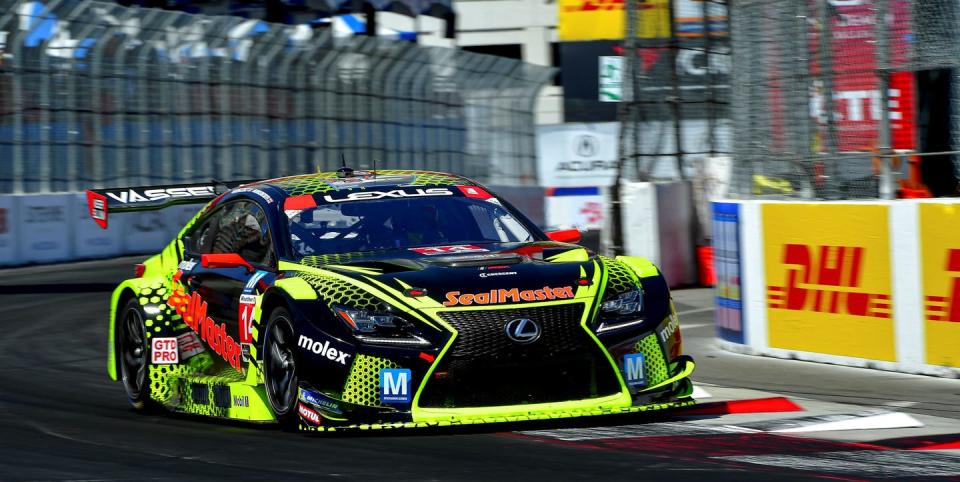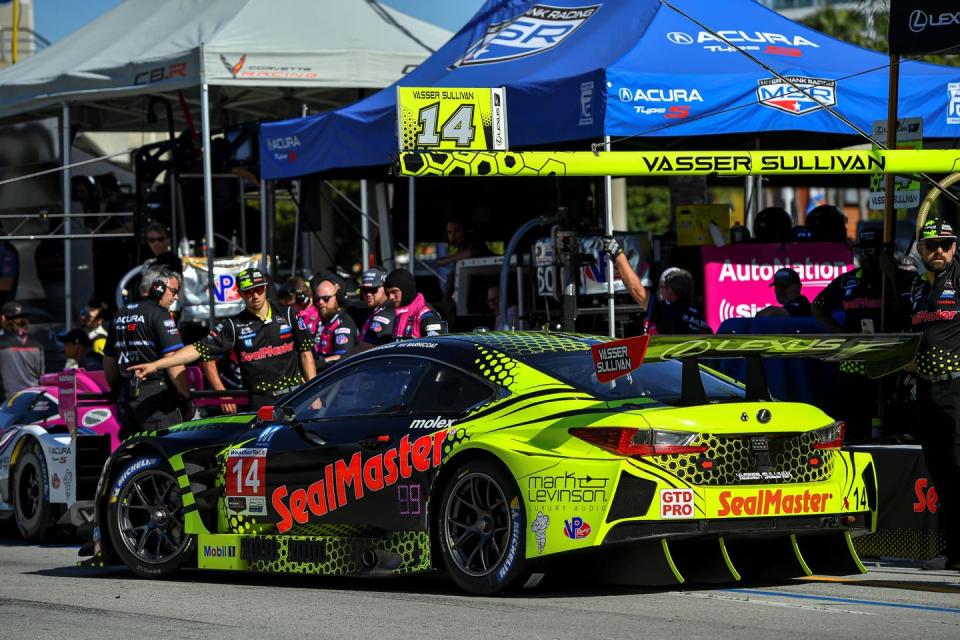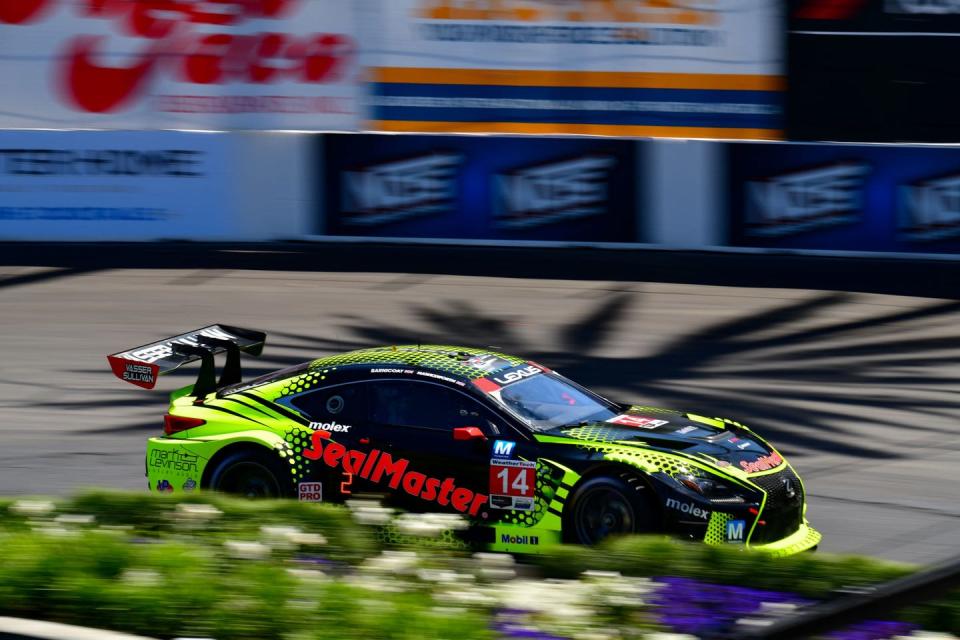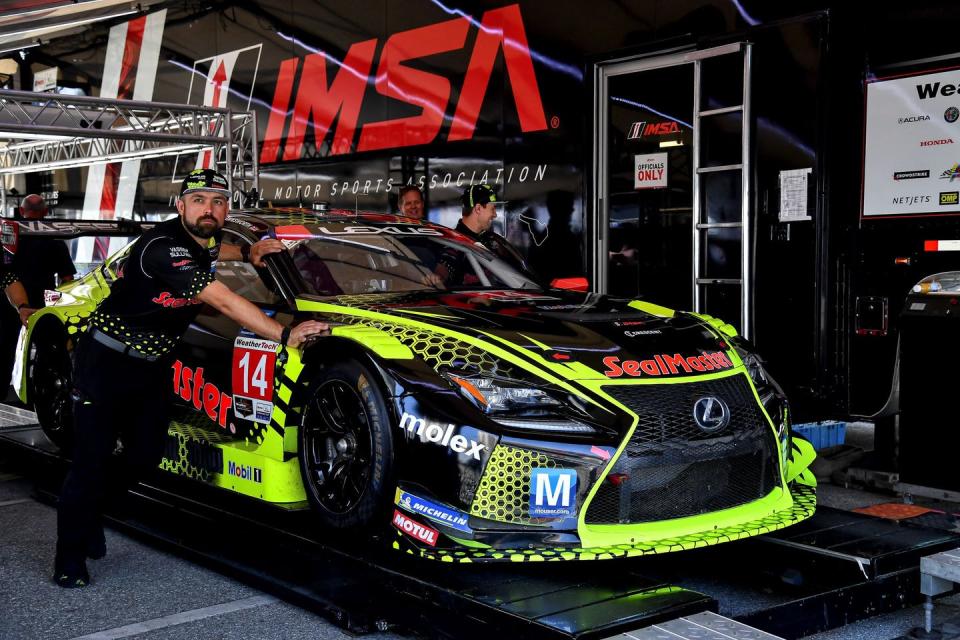Lexus Races in IMSA GTD Pro to Prove a Point

The Lexus RC F GT3 makes little to no sense. The RC F road car was revealed way back in February 2014, and both the engine and some components of the platform are sourced from variations of the Lexus IS that debuted in 2005. The race car is one of the heaviest in the GT3 rule set, a class that puts the RC F in direct competition with the McLaren 720S and Ferrari 488. And, yet, it races against factory and factory-supported cars from Corvette, Mercedes, Porsche, Acura, Lamborghini, Aston Martin, and BMW in America's most prestigious GT racing class anyway.
That did not happen overnight. When Lexus committed to racing an RC F GT3 in the GTD category ahead of the 2017 season, it was a pro-am class that played a clear second fiddle to the factory-only GTLM. Their deal with 3GT racing was seen as something controversial, the push of a factory-type program into a class that was meant to be reserved for privateers. 3GT helped alleviate those fears, in part, by failing to score a single podium in its debut season.

But Lexus kept developing the car. That turned to two wins in the 2018 season. In 2019, the Lexus RC F program moved over to AIM Vasser Sullivan. They scored two more wins. In 2020, the team took four wins and a sprint racing championship. Vasser Sullivan, now without AIM after separating from their partner team in 2021, was ready for prime time.
That announcement came late last year. GTLM, a class built around a GT2-based rule set that had long become too expensive and too niche to interest new factories, was retired after the 2021 Petit Le Mans. IMSA opted to replace it with GTD Pro, a category that is effectively just the long-standing GTD rule set with all of the specifications for amateur and non-factory racing removed. That meant Lexus, one of the anchors of the GTD class, was suddenly a choice away from the top step of the American GT racing world. They decided to move one of their two cars, the No. 14 anchored by longtime Lexus GT ace Jack Hawksworth, to the new all-pro category.
"It's what I've wanted, I've wanted to be in an all-pro lineup for a long time," Hawksworth shared. "You can rely on each driver to be more experienced, so you can work with a setup aligned with both drivers. You can rotate around your driver lineup, so for instance today I'm starting my first race in five years."

Hawksworth is joined in the car by Ben Barnicoat, a former McLaren GT driver who moved to the Lexus program this past offseason. Oddly enough, Barnicoat and Hawksworth grew up in South Yorkshire, racing on the same kart track a few years apart. Now, they lead a major program against Porsches and Corvettes together. It's an adjustment for Barnicoat, too:
It's my first year in IMSA, but the team has introduced me to all the new rules and regulations. Taking that step from GTD to GTD Pro, although the main difference is just the driver lineup, that changes the strategy massively. In GTD, you have to put that focus into your silver or amateur driver, because they're the ones who are qualifying and starting the races. Now, we're in a very lucky position where Jack and I are two pros at the top of our game and can change that strategy wherever we want. This weekend [at Long Beach] for example, Jack's been here before and it's my first weekend here, so with track position quite key we've decided to qualify and start Jack to get as high up the grid as possible. In the next race, we could have the freedom to do the opposite.
GTD Pro has one strange quirk, though. Since it was announced so late in the 2021 season, one major factory program did not actually have time to prepare a new car for the class. Corvette Racing is instead racing its C8.R as a balanced-in GTLM car for the next two years as it completes preparation of its GT3 racer, something the series has struggled with balancing through three races. At Daytona, the Corvette seemed lost in practice and qualifying. At Sebring, it sailed away for a dominant victory. Hawksworth understands the balance issue is the result of the series being asked to integrate one car built to an entirely different specification into an unrelated class, but seemed frustrated by the results early:
It's hard for the series to figure out how the car's going to work. It's built to a different set of regulations to what a GT3 car is built for. At Daytona, they weren't slow once the race started. They were running in the pack, they just had issues. They weren't fast in practice, but they weren't fast in practice at Sebring either, and as soon as qualifying and the race came, they went. It's difficult, for sure. It's hard enough in GT3 alone, with front and mid engine cars, big coupes and sports cars. Then you take another element, a car that's built to a different set of regulations completely and put them all together and try to balance it... It's tough. The race is competitive, though. It's always close, IMSA does a good job with that. But us, right now, our car is several years old compared to all of these other cars.

The issue is compounded by how much older the RC F, which debuted in 2017 and has not been significantly altered since, is than the rest of the class. Hawksworth knows that IMSA has far more information about its car than the rest of the field, which makes balancing the RC F with newer cars a unique challenge.
The Corvette's in our class, there's a new BMW, the Aston's still relatively new here, so there's a lot of data for IMSA to gather to understand where the car needs to be. If you go all the way back to 2017, other than changing the ABS systems, the car is exactly the same. It can be an advantage for them, when you bring in an evo kit or a new car, it resets everything. The governing body has to figure out where it slots, where they know who we are.
With the McLaren 720S also new to the category and the Acura NSX, Mercedes AMG GT, and Lamborghini Huracan getting new "evo" development packages in recent years, the Lexus stands out as one of the oldest in addition to being one of the strangest. Now that Lexus is firmly committed to fighting for wins and championships in the new GTD Pro category, following the RC F up with a racing car that more directly competes with these new supercars is a major priority. Lexus motorsports manager Jeffrey Bal seemed to indicate that future will be tied to the other GT3 car in the Toyota stable, a GR-branded GT3 concept not tied to any existing road car debuted at the Tokyo Auto Salon earlier this year. That car is currently projected to arrive in 2024.
That new car, still conceptual until Lexus has something to announce, would be the centerpiece of a Lexus focus on performance excellence. Its present-day sports car lineup, anchored by the truly great LC 500, is built around the way performance and comfort complement each other. This would instead be a dedicated performance car, built from the ground-up with auto racing in mind as part of a long-term push to grow the way customers see the Lexus brand.
Until then, Lexus is getting by showing customers its potential by fighting the AMG GTs, M4s, and C8s of the world with the RC F GT3 it already has. Although the program was in dire straits early, dangerously close to ending until it started winning races, it now carries an expectation of championship contention into every season. Bal says that dealers are starting to notice the strength of the program, including a massive Lexus dealership two hours away from the track in Escondido that hosted the team days before the Long Beach race. Customers, too, are starting to see "Lexus" and "racing" as two things that can fit together, even when that racing is built around the largest and oldest car in the category.

But the RC F GT3 is one of the more powerful cars in a GTD class that tries to balance different types of cars by their power-to-weight ratio, making it particularly effective at faster tracks. This means it is also one of the heavier cars, and by extent particularly ill-suited to a street circuit like Long Beach.
After penalties to two of the three new BMW M4 GT3s, Hawksworth started the race fifth among all GT cars and fourth in GTD Pro. As expected, the Corvette C8.R was the class of the field and passing was a challenge throughout the 100-minute sprint. Hawksworth held position behind the Corvette, the Pfaff Porsche, and the Heart of Racing Aston Martin until the day's only pit stop, at which point a Rube Goldberg Machine of a moment opened the door for something magical.
ICYMI: The pit stop that ended our day at the @GPLongBeach. “Never been seen” and “uncontrollable circumstance” are a couple phrases we’ve heard to describe this… #IMSA | #PlaidPorsche | #FueledByDriveway | #AGPLB pic.twitter.com/MwFiPBkBN5
— pfaffmotorsports (@pfaffmotorsport) April 10, 2022
On their stop, the Corvette team lost control of a lugnut. That's a penalty, eventually a drive-through that demoted the C8.R to third in class. That lugnut bounced out of control until it came to the Pfaff Porsche team's pit stall while the team was servicing their car. Here, you can hear a crew member exclaim "Whoa!" as it bounces over the top of the car to hit the fueling rig square at speed. Then it bounces down into the radiator, the radiator of a rear-engined 911 that can be accessed only by an inverted vent in what would be the front storage compartment of a road car. The bounce off the fueling rig lets it hit at just the right angle to destroy the radiator, ending the Porsche's day in an instant.
With Barnicoat now in the car, the Lexus was up to second.

A few incidents further back in the field led to multiple cautions, chances to either pass the Aston Martin now leading or be passed by the Corvette now back up to third. But the GTD-leading BMW behind played unintentional defense on the Corvette and the narrow track created few real chances to pass the Aston Martin, so the Lexus stayed in second. The entire Vasser Sullivan team, both the crew of the No. 14 GTD Pro entry and the No. 12 that still competes in the pro-am GTD class, erupted in celebration. It was as unlikely a podium as podiums get.
The RC F is in its sixth IMSA season of an anticipated seven. Over the next year and a half, the team will fight factory efforts from just about every single Lexus rival for the most significant American GT racing title it could claim. For a company still hungry to be seen competing for a spot in the performance car world, that championship would mean everything.
You Might Also Like

 Yahoo Autos
Yahoo Autos 